Introduction
The oil and gas industry is one of the most important and crucial industries in the world. Because of the availability and affordable cost of production in mining of this resource, oil and gas has been the primary source of energy globally for many decades now (Fenwick, 2011). The trends in growth of any country normally measured in GDP is inextricably linked to the availability, cost and supply of oil and gas commodity within that country as it is a factor that impacts on virtually all other sectors of the economy (Fenwick, 2011).
Indeed, oil and gas are primary raw materials for many key industries such as petrochemicals, fertilizer manufacturing Companies, pharmaceuticals and plastics which are widely used in many countries (Fenwick, 2011). Despite the critical role that petroleum industry plays in the world, this resource is found in politically unstable and unsafe countries very different from what exist in other countries that are the consumer countries. Most of these oil producing countries are enjoined by a single organization referred as OPEC which is responsible for regulating production and sale of oil globally (Fenwick, 2011).
There are four oil extraction techniques that have been proven very effective, these are gas injection using CO2, horizontal drilling, steam injection and directional drilling; the implication of these oil drilling methods in the oil industry is what will be our focus on this paper (Bowden, 2011). The immediate implications of these technologies in the oil sector has been that peak oil phenomenon which was thought to happen in about twenty years from now has been pushed farther by several decades.
Certainly, there is no doubt that the current level of technology is going to be very influential in attaining steady oil supply and I want to posit in this paper that the future of the oil industry is dependent on the current technological advances that exist in extraction of oil and related resources. This paper will also discuss new developments that have been emerging as a result of these challenges in the oil sector and how they are shaping the industry prospects for growth and sustainability currently and in the future.
Background Information and Trends in the Oil Industry
The world’s highest known reserves of oil are found in the Middle East with Saudi Arabia having the highest reserves; it is estimated to have about 270 billion barrels of oil (USEIA.com, 2011). Among the countries with the highest reserves are Saudi Arabia, UAE, Qatar, Libya and Morocco amongst others (Bowden, 2011). Being a non-renewable resource whose demand has increased tremendously driven by growth in the developing world especially China and India, oil prices have been increasing constantly to a level where they now threaten the global economy as a whole (Fenwick, 2011).
The world also faces the prospect of the production of oil reaching its peak or even reducing to a level where it may not be sufficient to meet global energy needs (Fenwick, 2011). In addition, the cost of drilling oil from conventional sources has been increasing as the resource is being depleted at a faster rate than it can be sustained which means deeper and further drilling is necessary (Fenwick, 2011).
The sustainability of oil supply is therefore a critical issue in the world today since oil is a non-renewable resource; as the world economy and population continue to grow mainly in the developing world the demand for oil has continued to increase
(Bowden, 2011). Indeed, the trend over the years of oil and gas prices demonstrates the dire need that faces policy makers in coming up with viable solution that can effectively address the looming shortage of oil and gas resource that is now imminent. The graph below indicates the sustained high oil prices that have been the trend over the recent past. The two spikes depicted by the graph are among the highest in the history of oil prices and have been attributed to two factors; one, the rapidly depleting oil reserves and secondly the political instability that is currently underway in majority of oil producing countries (Bowden, 2011).
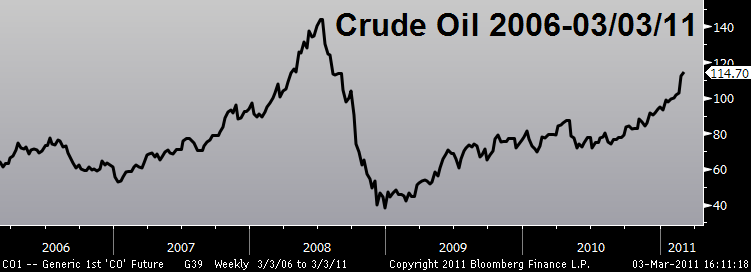
It is on this backdrop that major global Companies and countries that especially rely on oil are on the race of seeking new ways to solve the threat that surrounds the world energy sector. To counter this, non-renewable energy sources have been touted as the solution to this dilemma but so far the costs and level of available technology is not adequate to substitute the use of oil and gas resource. The good news is that massive new reserves have been discovered in new geographical locations and reserves that were previously not accessible have become accessible thanks to the technological advances.
There are four new technologies that have been invented over the recent past which have contributed immensely to the rate at which new oil reserves are being discovered as well as the speed at which oil is being mined.
Current Well Injection Techniques
CO2 Gas Injection
Well injection using steam or chemicals is a type of enhanced oil recovery (EOR) methods that is being used to increase production levels of oil resources (Carroll, 2007). Like the rest of other EOR techniques the major advantage of using this method in oil and gas extraction is because of its ability to increase the level of production by up to 15% since this method greatly reduces the viscosity of the crude product thereby maximizing its extraction to the surface (Carroll, 2007).
Besides this, use of CO2 is cost effective since Co2 is not costly and is usually recycled during the extraction process (Carroll, 2007). The process of using Co2 in oil and gas extraction involves injecting Co2 to the reservoir at the right pressure and mixture so as to lighten the crude and facilitate its extraction. Because of this a major disadvantage of Co2 gas injection is the hazard that this process poses to the environment in the event of Co2 leaking to the environment. The following diagram depicts the process of oil extraction using Co2 gas injection method. A good example of a project where this method of oil and gas extraction has been used is in Canada, Weyborn Field project.
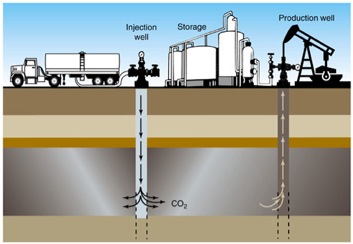
Steam Injection
Use of steam in the mining of oil and gas is very much like use of gas since the idea is to ensure the crude oil or the gas is mixed with steam which makes it easy to extract from the reservoir and transport it; as such it is also a form of well injection method (Carroll, 2007). Steam injection can be done in various different ways but whichever method is used the process involved is the same and entail pumping steam at certain temperatures to an oil reservoir for purposes of loosening the crude to a form that can easily be extracted and pumped to the surface (Carroll, 2007).
Because steam injection is a form of EOR its major advantages are that it is cost effective and very efficient; on the other hand it poses environmental hazards because of the toxicity of the byproducts when steam is combined with crude oil. This is because use of steam in extracting oil breaks down the crude oil to unstable elements such as sulfur oxide and nitrogen among others that are dangerous to both human health and environment. The diagram below shows the process of oil extraction by steam injection.
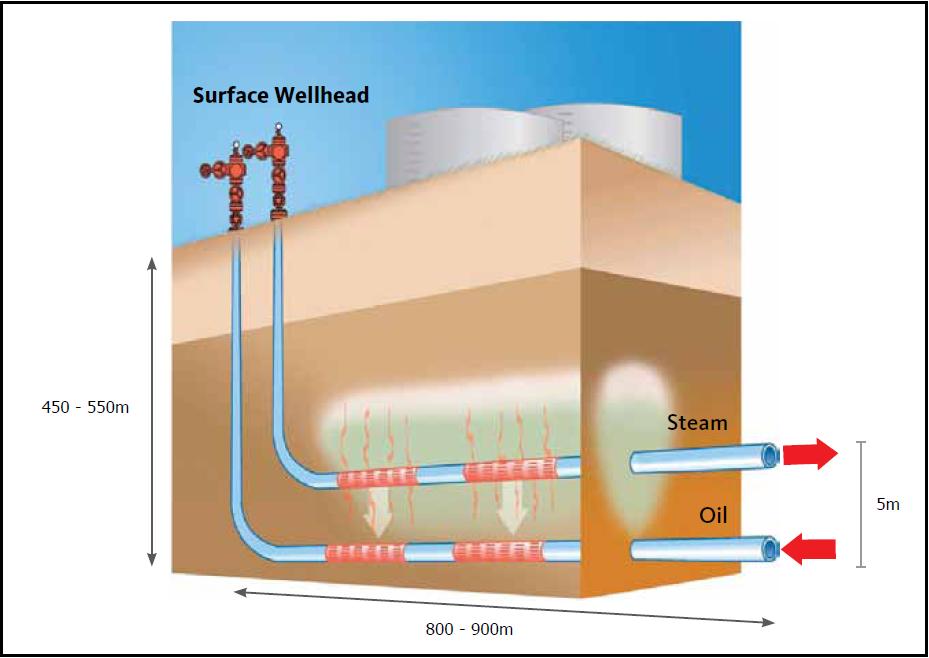
Current Drilling Methods
Horizontal Drilling
The horizontal drilling technique is very much like directional drilling since both methods uses the same concept in extraction of oil or other mineral from their reservoirs’. Horizontal drilling is described as an “enhanced oil recovery method (EOR) in which the lower part of the well bore parallels the oil zone”; this means that the angle of the well is more or less perpendicular to the source of the reservoir at any one point (HorizontalDrilling.org, 2007). This method of drilling has its advantages and disadvantages; there are several advantages but the main one is that it offers increased surface area contact than the other methods which translates to increased rate of extraction compared to other methods which is estimated to be as much as 3:1 on ratio comparison basis (HorizontalDrilling.org, 2007).
But on the other hand, horizontal drilling method is significantly costly because it involves circumventing geological or manmade structures in order to access the mineral resource reservoirs’ (HorizontalDrilling.org, 2007). Because of these inherent advantages offered by horizontal drilling some of the biggest oil mining exploration projects such as the East-West gas pipeline Vasishta Godavari in India, Offshore pipeline project in Porto Viro Venice in Italy and Project Abu Dhabu in UAE are being run using this method (HorizontalDrilling.org, 2007). The diagram below indicates a typical example of horizontal method of drilling.

Directional Drilling
Directional drilling involves use of slanted or non vertical wells to access the oil reserve; it is a drilling process that involves deviating a wellbore along a planned path to a target located at a given lateral distance and direction from a vertical point (MiningTechnology.com, 2006). It allows for oil to be accessed from a point that is not directly above it; this enables accessibility of oil reserves for instance to be possible in built up areas like cities or in sensitive ecological areas such as lakes (MiningTechnology.com, 2006).
It also enables drilling under hard rock previously not possible. Direct drilling is also used where one exit point is made up of multiple well, this results in one rig for several wells thus reducing the cost of exploitation of the resource being mined (Carroll, 2007). Thus, the recent advent in directional drilling technology has two major implications to the oil industry; one, because directional drilling applies relies on use of single point referred as “parent drill” to channel all oil that is being drilled, the results are increased rate of extracted oil than previously existing methods (MiningTechnology.com, 2006).
Secondly, use of this technology in mining of oil is both cost effective and time efficient as it saves time spent on exploration of oil resource and the associated costs of extracting it; other benefits of this type of mining is that it preserves the environmental structure since the entry points are very small (MiningTechnology.com, 2006). An example of where this technology is being applied successfully is in UK and Chile (Copland, 2011). The diagram below accurately demonstrate one of the most popular types of directional drilling that is commonly used in the oil mining industry.

In the following section let us briefly discuss the current technology used in laying the infrastructure for transportation of both oil and gas resources.
Transportation
Oil and gas are increasingly being transported through pipelines; thus heavy investment is being made in this form of infrastructure all over the world. There are various modes of transport that can be used when transporting both gas and oil and the choice of which method to use largely depends on the cost factor and time taken. The major methods of transport include road transport, tanker transport, rail transport and use of pipeline; the last is the most recently developed method which also happens to be the most cost-effective as well as the most efficient than any of the rest (Arjun, 2010).
It is for this reason that countries are increasingly relying and undertaking huge investment just on this mode of transport and for very good reasons when you consider the many advantages that this mode of transport offers. Use of pipelines in transportation of oil and gas is a recent development that has been made possible because of the advent in technology just like the case with the oil extraction methods that we have discussed above.
This means that as new technology become possible so did the trend in transportation of gas and oil resources; the major advantages of using pipelines are that it is fact, economical, multipurpose and very safe (Arjun, 2010). But on the other hand this infrastructure is not cost effective or possible to transport small quantities of these resources. In addition, it can only transport one form of oil at a time since it cannot mix them plus the fact that it involves a lot of initial investment more than all the any other modes of transport (Arjun, 2010).
Indeed, use of pipeline in transport of gas, Co2 and oil resources is the most common method worldwide; Europe for instance is supplied with gas by pipelines that traverse thousands of miles over land and sea from Central Asian countries such as Kazakhstan and Russia.
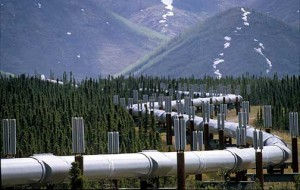
Other methods of transporting both oil and gas include massive supertankers; such as Sirius Star and Mv Vela ships that can carry millions of tons of these resource which are shown in the diagram below. Large supertankers are especially suited in transporting of gas that is in form of LNGas well as liquefied Co2 gas.
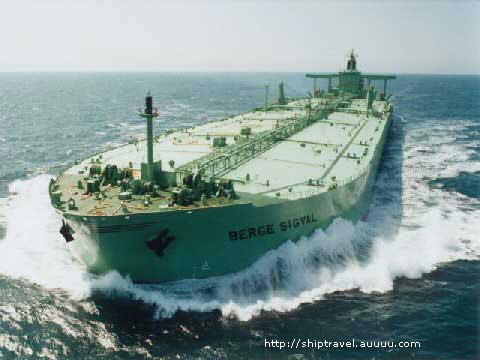
Geographical Frontiers Factors
The factors of geographical frontiers greatly impacts on the availability, stability and future supplies of oil and related resources globally. There are three major reasons why this is so; one, because of the political issues encompassing such regions, challenges related to accessibility of oil and gas resources in these regions and finally limitation of current technologies in terms of cost effectiveness and accessibility. All these factors combines together intractably to reduce the geographical frontiers of oil resources that we can be able to effectively utilize.
Thus, we find that because of geographical frontier factors most new found resources are in territorial contested areas such as Russia and Japan Kurile Islands, Japan and China over the Senkaku/Diayou Islands and Malaysia/Brunei oil disputes in South China Sea among others (NationalEnergyBoard.com, 2006). Other issues that still exist are the Russia and Norway conflict over the Barents Sea and the multinational oil Companies claim over the Arctic resources. The vast resources in these disputed regions require cooperation between these countries in order to exploit the resources effectively but which unfortunately for now prevents us from accessing the much needed vital resource.
Finally, there are still vast and sizable oil resources in various regions that have not yet been exploited notably in Africa, Antarctica and the Pacific and Indian Oceans. In most of these regions, what is needed is more advanced technologies that will be able to effectively access and extract these oil resources.
Conclusion
Oil is the most important resource in the world, it is important for driving the growth of economies in both the developed and developing worlds. The price of oil and instability of supply coupled with the threat of peak oil phenomena has made it necessary for countries and companies to seek alternative sources of fuels. Most of these alternatives are promising but are not viable and oil remains the only option.
New technologies such as direct drilling, deep water drilling and extraction of oil from sand and shale are increasing the capacity of the world to satisfy its demand currently and into the future. New frontiers such as the arctic, oceans can now be exploited because of advanced use of technology. In addition, new developments in transport of oil such as pipelines and supertankers are making it possible and cheaper to transport the commodity. The prevailing high prices of the commodity make such investments attractive.
As the world continues to discover new oil sources such as in the Antarctica and oceans, current oil constraints might ease a little. The effect of oil on climate change needs to be checked and controlled and this will require technologies in storage and sequestration of carbon dioxide.
References
Arjun, T. 2010. Companies Building Alaska Natural Gas Pipeline Prepare for Open Season. Web.
Bowden, J. 2011. Oil: into new frontiers. Web.
B.P. 2011. BP Statistical Review of the Year 2007. Web.
Carroll, J. 2007. Energy companies pin hopes on shale oil in Colorado and Utah.2007. Web.
Copland, M. 2011. UK Mining, the Oil & Gas Industry & the Rescue of the Chilean Miners. Web.
Fenwick, S. 2011. Is time running out? Web.
HorizontalDrilling. 2007. Horizontal – Directional Oil & Gas Well Drilling. Web.
MiningTechnology. 2006. Directional Drilling Promises Benefits for Industry. Web.
NationalEnergyBoard. 2006. Canada’s oil sands: Opportunities and challenges to 2015 – an update. Web.
US. 2011. Energy Policy Act Section 369. Web.
USEIA. 2011. Saudi Arabia. Web.
WorldEnergyCouncil. 2005. Shale Oil Resources and Production at end-2005. 2005. Web.
Watkins, E. 2011. Qatargas 4 ships first cargo of LNG to India. Web.